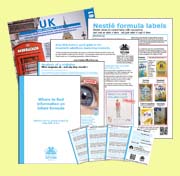New Zealand ASA upholds complaint against Wyeth for S26 Lutien eye claim
New Zealand ASA upholds complaint against Wyeth for S26 Lutien eye claim
Two magazine advertisements published in Littles were both very similar and featured the headline piece which read:
“SEE THE WORLD THROUGH THEIR EYES”
They also featured a picture of a baby’s eye(s). Part of both the advertisements read “S-26 GOLD® TODDLER is now forfeited with Lutein. Naturally sourced from the marigold flower, Lutein is a clever antioxidant that nutralises free radicals, helps support eye health and may help shield precious little eyes.”
DECISION Meeting 9 November 2010 Complaint 10/60
Complainant: D. Henderson Advertisement: Wyeth (NZ Limited)
Complaint: Wyeth New Zealand advertised S-26 Gold Progress formula for babies.
Magazine advertisement: Two magazine advertisements published in Littles were both very similar and featured the headline piece which read:
“SEE
THE WORLD
THROUGH THEIR EYES”
They also featured a picture of a baby’s eye(s). Part of both the advertisements read “S-26 GOLD® TODDLER is now forfeited with Lutein. Naturally sourced from the marigold flower, Lutein is a clever antioxidant that nutralises free radicals, helps support eye health and may help shield precious little eyes.”
Website advertisement located at www.wyethnutrition.co.nz: The following text was featured on the webpage entitled “What you need to know about LUTEIN?” which read “Lutein not only helps neturalise the effects of not so friendly free radicals but it may also shield developing eyes by acting as a filter against high energy blue light. It is considered an important nutrient that helps support the developing eye.” The website also featured the text as a banner advertisement:
“NOW WITH
LUTEIN
THE CLEVER ANTIOXIDANT
FOR PRECIOUS LITTLE EYES”
The website also contained an image of a baby’s eyes and the text “It’s focus on eye health”.
Deliberation
The Complaints Board read all the correspondence relevant to the complaint and viewed the different advertisements. It noted the Complainant D. Henderson was of the opinion that the claims in the advertisement with regard to the benefits of Lutein should be withdrawn as there is insufficient evidence to support the claims.
The Chairman, noting that the advertisement had been in circulation prior to the release of the Code for Advertising of Food 2010, directed the Complaints Board to consider this advertisement with reference to Principle 2, and Principle 4, Guideline 4(a) of the Code for Advertising of Food 2006.
The task before the Complaints Board was to determine whether the advertisement by implication or exaggerated claim deceived or misled the consumer or exploited the lack of knowledge of consumers, and in addition whether the advertisement had been prepared with a high standard of social responsibility expected of advertising of this nature. It also required the Complaints Board to consider whether all the nutrient, nutritional and health claims are factual, not misleading, and able to be substantiated.
The Complaints Board noted that both magazine advertisements were similar and both contained the claim: “S-26 GOLD® TODDLER is now forfeited with Lutein. Naturally sourced from the marigold flower, Lutein is a clever antioxidant that neutralises free radicals, helps support eye health and may help shield precious little eyes.” It further noted a similar claim was made in the website advertisement which said “Lutein not only helps neturalise the effects of not so friendly free radicals but it may also shield developing eyes by acting as a filter against high energy blue light. It is considered an important nutrient that helps support the developing eye.”
The Complaints Board firstly turned to consider the magazine advertisements which both comprised similar elements. It noted that the advertisement in the headline piece read “See the world through their eyes” and further noted that it was displayed in the same format as an eye chart with the text gradually getting smaller as it went down the page. It also noted the close-up picture of the baby’s eye(s). The Complaints Board observed that both the magazine advertisements had appeared in publications targeted at parents with young children.
The majority of the Complaints Board said that although the claims being made with regard to Lutein were not absolute and noted the use of phrases including “helps support” and “may help”, it considered the level of moderate language was undermined by the picture of the baby’s eyes, the use of an eye chart design, and the headline piece. It considered that the overall likely consumer take-out of the claim was that the consumption of Lutein in the formula would help children’s eye health and that this support was not likely to be obtained from other sources. It noted the substantiation provided by the Advertiser for the claim, however, in the majority view, the level of substantiation did not support the likely overall consumer take-out. The majority therefore ruled that the advertisements had reached the threshold to breach Principle 4 of the Code for Advertising of Food 2006. It also considered that the advertisements had not been prepared with a high standard of social responsibility to consumers and society as required by Principle 2 of the Code for Advertising of Food 2006 where nutritional claims are being made.
Turning to the website advertisement, the majority of the Complaints Board said that the overall impression and likely consumer take-out was the same as the magazine advertisements given the similar elements, including close-up pictures of a baby’s eyes and the text “NOW WITH LUTEIN THE CLEVER ANTIOXIDANT FOR PRECIOUS LITTLE EYES” being in the same format as an eye chart.
The majority said the claims contained in the website advertisement, combined with the likely consumer take-out also reached the threshold to breach Principle 4 of the Code for Advertising of Food 2006. It said that the advertisement had not been prepared with a high standard of social responsibility to consumers and society as required by Principle 2 of the Code for Advertising of Food 2006 where nutritional claims are being made.
A minority of the Complaints Board disagreed. It was of the view that the magazine advertisements and website advertisement were not misleading and deceptive nor exploiting the lack of knowledge of consumers given the moderate language used in the advertisements. It also considered that the advertisements had been prepared with a high standard of social responsibility. The minority said that the explanation provided by the Advertiser substantiated the claims and it accepted their response where they said that “The claims merely state that Lutein is an antioxidant and has a role in normal eye health.” The minority ruled that the advertisements were not in breach of Principle 4 and had been prepared with a high standard of social responsibility as required by Principle 2 of the Code for Advertising of Food 2006.
The Complaints Board then turned to Guideline 4(a) of the Code for Advertising Food. It noted that this Guideline specifically related to nutritional claims and compliance with the Food Standards Code. The Complaints Board accepted the evidence from the Advertiser that the information in the advertisement complied with the Food Standards Code. The Complaints Board considered that the advertisements did not reach the threshold to breach Guideline 4(a) of the Code for Advertising of Food.
In accordance with the view of the majority, the Complaints Board ruled to uphold the complaint under Principles 2 and 4 of the Code for Advertising of Food 2006.
Decision: Complaint Upheld
http://www.ifanz-ibfan.org.nz/home3.htm
- Login to post comments






